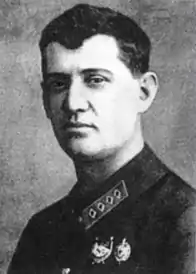Stanislav Redens | |
|---|---|
| Станислав Реденс | |
 Redens in 1931 | |
| People's Commissar of the Internal Affairs of the Kazakh SSR | |
| In office 21 November 1938 – 20 January 1938 | |
| Preceded by | Lev Zalin |
| Succeeded by | Semyon Burdakov |
| Chairman of the OGPU under Council of People's Commissars of the Ukrainian SSR | |
| In office 25 July 1931 – 20 February 1933 | |
| Preceded by | Vsevolod Balitsky |
| Succeeded by | Vsevolod Balitsky |
| Chairman of the GPU under the Council of People's Commissars of the Byelorussian SSR | |
| In office 1 May 1931 – 1 June 1931 | |
| Preceded by | Grigory Rappaport |
| Succeeded by | German Matson |
| Personal details | |
| Born | 12 June 1892 Tykocin, Łomża Governorate, Russian Empire |
| Died | 12 February 1940 (aged 47) Moscow, Russian SFSR, Soviet Union |
| Nationality | Soviet |
| Political party | RSDLP (Bolsheviks) (1914–1918) Russian Communist Party (1918–1937) |
| Spouse | Anna Alliluyeva |
| Military service | |
| Allegiance | Russian Soviet Federative Socialist Republic |
| Battles/wars | First World War Russian Civil War |
| Awards | Honorary Officer of State Security |
Stanislav Frantsevich Redens (Russian: Станисла́в Фра́нцевич Ре́денс, Polish: Stanisław Redens; 17 May 1892 – 21 January 1940) was a Soviet NKVD official, one of those responsible for conducting mass repressions under Joseph Stalin. Redens was himself executed in 1940, after being arrested at the end of the Great Purge in 1938.
Early life
Born to a Polish worker’s family in Tykocin in the Łomża Governorate of the Russian Empire, Redens received a limited education and began working in metallurgy in 1907. A Bolshevik since 1914, he was briefly mobilized into the army during World War I but was soon demobilized and returned to political activity in time for the 1917 Russian Revolution.
Career
Redens began to work for the newly established Cheka in 1918, amid the Russian Civil War. He was energetically involved in dekulakization in Ukraine, serving as the head of the Odessa Cheka. Redens held important positions in the Crimean GPU in 1922–1923.
Though made a chief of the Transcaucasian GPU in 1928, Redens was gradually sidelined by his own deputy Lavrenty Beria.[1] In 1931, he was appointed the OGPU head in the Byelorussian SSR and then in the Ukrainian SSR. During his tenure in Ukraine, Redens gained fame for crackdown on farmers, which contributed to the Holodomor, the starvation of millions of Ukrainians as part of a larger famine across the Soviet Union. In January 1933, he was recalled to Moscow and placed in charge of the NKVD units in the Moscow Oblast where Redens spearheaded purges following Sergey Kirov assassination in 1934.[2]
Redens was elected to the Supreme Soviet of the Soviet Union in 1937 and appointed as People's Commissar for Internal Affairs of the Kazakh Soviet Socialist Republic in 1938. He was arrested on charges of being a member of “Polish subversive-spying group” in November 1938 and shot in January 1940. He was rehabilitated under Nikita Khrushchev in 1961.[2]
Personal life
Redens was married to Anna Sergeyevna Alliluyeva (1896–1964), sister of Stalin’s second wife Nadezhda Alliluyeva, also an Old Bolshevik and former Cheka officer who spent 6 years in prison under Stalin. Their son, Vladimir Alliluyev (Redens) (born 1935), published, in 1995, his memoirs "Chronicle of a Family" which advocated Russia's return to Stalinism and was condemned by Stalin’s daughter Svetlana Alliluyeva.[2][3]
References
- ↑ Amy W. Knight (1993), Beria: Stalin's First Lieutenant, pp. 41–44. Princeton University Press, Princeton, New Jersey. ISBN 0-691-01093-5
- 1 2 3 (in Russian) Реденс Станислав Францевич (Redens, Stanislav Frantsyevich). Hrono.Ru. Retrieved on April 27, 2009
- ↑ Melissa Akin. Stalin’s daughter shuns public attention. Las Vegas Sun. June 13, 1996
